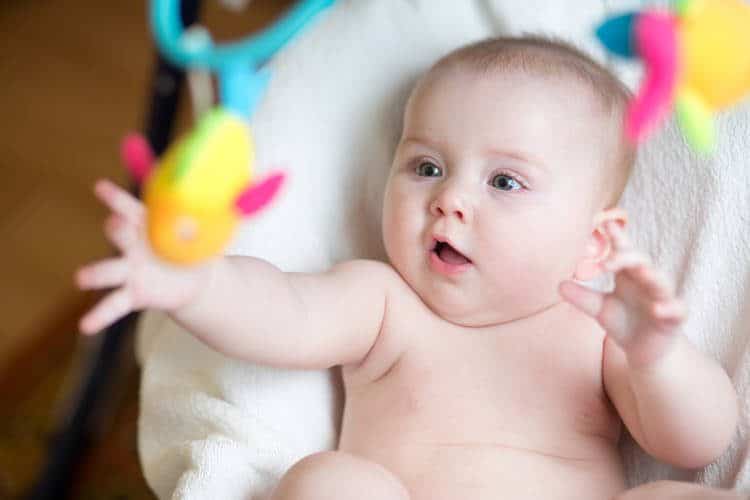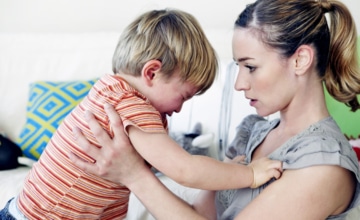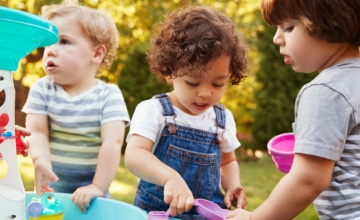Your Child’s Vision
Children need healthy vision to explore and learn about their world. Healthy vision helps infants and toddlers play, touch, reach, grasp, and learn to feed themselves. Later, visual skills help preschoolers learn to read and write, kick, throw and catch, and even recognize a friend across the playground.
The First Year
Did you know babies’ vision continues to develop after birth? Your newborn sees best at a distance of 8–15 inches. Perfect for them to gaze into your face as they’re fed! As they grow older, you’ll notice new milestones as their vision changes and their world expands:
- Birth–1 month: Baby begins to follow slowly moving faces, lights, and objects.
- By 2–3 months: Baby begins to notice their hands, makes eye contact with a parent or caregiver, and is able to see and return their parent’s smile.
- By 3–4 months: Baby reaches for objects or a parent/caregiver’s face. Baby grasps and holds objects.
- By 5 months: Baby brings objects to his/her mouth.
- By 6–7 months: Baby purposefully reaches for objects.
- By 8–10 months: Baby recognizes the faces of family members and/or caregivers and looks at small objects, such as cereal or a raisin.
- By 12 months, baby uses their index finger to point to pictures in a book or looks for an object dropped in a container.
Remember that all milestones are estimates. If you have questions or concerns about your baby’s visual skills, check with your pediatrician. Read more about vision development in English and Spanish.
Vision Problems: What to Look For
It’s hard to know when young children can’t see well. Recognizing possible vision problems is the first step toward connecting children with the help they need. Here’s what to look for:
- Rubs eyes or blinks often
- Closes or covers one eye when looking at a close object
- Squints eyes when trying to see objects near or far away
- Tilts head or turns face when playing with a toy, trying to read, or trying to see something near or far away
- Brings toys or books close to his or her face
- Unable to see something other people can see
- Avoids activities that require close-up vision, like reading or drawing
- Seems unusually clumsy, frequently bumps into things
You can learn more about other signs to look for here in English and Spanish.
What to Do If You Suspect a Vision Problem
The good news is that most early childhood vision problems can be treated. And the most common treatment is eyeglasses! Well-child visits should include vision screenings. Make sure to talk with your child’s health care provider about any concerns. If you suspect your child is having trouble seeing or if they receive a vision screening referral, here’s what’s next:
- Schedule and keep an appointment with an eye doctor. Make a list of your questions and bring it with you.
- You can find an eye doctor here. Take a look at these suggested questions to ask your doctor in English and Spanish.
- Before the visit, prepare your toddler by talking about what the doctor will do. You might even role-play the appointment by using a stuffed animal or doll. This helps your child feel more comfortable at the appointment because they know what to expect.
- Follow the prescribed treatment and be consistent. Your child may need a few weeks to get used to their eyeglasses. Toddlers often resist requests (like wearing their eyeglasses!) as a normal part of their developing independence. Shift the energy by offering a choice: “You can decide between two choices. If you wear your eyeglasses, you can see the pictures in the story better. If you don’t wear your eyeglasses, the pictures in the book will look fuzzy. What sounds like more fun to you?”
- Share the eye examination results and treatment plan with the people who care for your child, like their child care provider or teacher. If your child is receiving early intervention, your home visitor can also meet with your child’s other caregivers to give them strategies and ideas for supporting your child’s growing visual skills.
Got Glasses? Here’s What to Do Next
Read stories that feature illustrations with children or animals who wear eyeglasses. (Try Peppa’s First Glasses or Little Bear Needs Glasses by Bernd Penners.) Point out or show your child photos of family members or other important people in their lives who wear eyeglasses. Giving your child lots of positive exposure to role models can build their confidence and comfort with eyeglasses or other treatments.
There are now dolls and other play figures available with eyeglasses. Toys like these can also increase your child’s comfort, familiarity, and confidence.
As your child begins to experience the benefits of eyeglasses or other treatment, you may see them enjoying new activities. Coloring, painting, stickers, and books with detailed illustrations may hold a new fascination. Your child may also show a new joy in the outdoors as they uncover the wonder of individual leaves or petals. Now that your child can see well, your child may feel more confident attempting new physical challenges. Noticing these changes and giving your child lots of opportunities to explore their new visual skills through play of all kinds will support their early learning and development. Your presence—and shared delight in their discoveries—will also strengthen the connection between you.
Remember, childhood vision problems can be hard to spot. If you suspect a vision problem, don’t wait. Only an eye examination by an eye doctor (ophthalmologist or optometrist) will identify a vision issue and what treatment, if any, your child needs.




